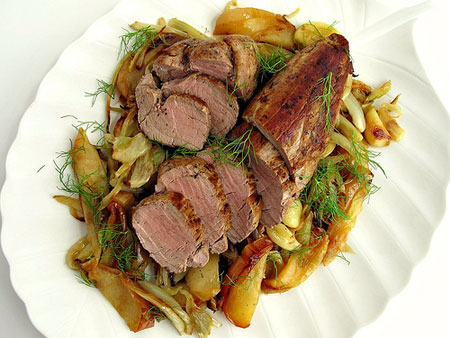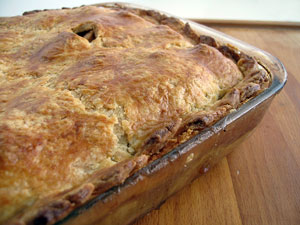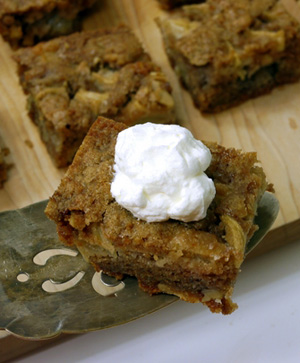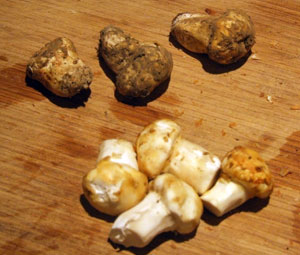 Apples are officially in season and I'm excited to get cooking and baking with them. Fall is one of the best seasons for food, just because there's finally an opportunity to make hearty meals that all appeal to our comfort zone. Apples, more than any other fruit, best represent the season. They're combination of sweet and tart flavors, contradictory as well as complementary traits, seem to fit the unpredictability of autumn just perfectly.
Apples are officially in season and I'm excited to get cooking and baking with them. Fall is one of the best seasons for food, just because there's finally an opportunity to make hearty meals that all appeal to our comfort zone. Apples, more than any other fruit, best represent the season. They're combination of sweet and tart flavors, contradictory as well as complementary traits, seem to fit the unpredictability of autumn just perfectly.
Apples also have the trait of being able to go well in sweet and savory recipes. The pairing of apples and pork were almost made to go together. (Just think of how many times as a kid you've had pork chops with apple sauce.) So for a recipe that's perfect for fall, here's a dish of roasted pork tenderloin with sweet apples and aromatic fennel. This recipe is quick for dinner any night and it's even elegant enough for a dinner party.
The secret to a good roast loin is getting it seared as brown as you can get it—the darker, the better it looks and tastes. So to help that along, I spread the loin with an herb butter, which serves two purposes: First, it helps brown the meat and second, it imparts wonderful flavor. Just make sure not to overcook the pork—a bit of blushing pink while cutting in is just what you're looking for.
Fall
Fall
Deep Dish Apple Pie
 It's that time of season where the leaves begin to fall and so do the apples. Though seeing summer end is bittersweet, early fall in all its glory is one of my favorite times of the year, mainly because of apple season. Picking apples at this time of year is a tradition in many families, as it is in mine. I always go to Silverman's Farm to pick the most beautiful apples available in a wide array of varieties. My absolute favorite apples to eat are Honeycrisp and Jonathan, but my favorite apples to bake with are Cortland and Crispin (aka Mutsu). Every year I bake an apple pie with varying results. In the end I always try to make a better one than in the previous year, perfecting my own so-called perfect recipe.
It's that time of season where the leaves begin to fall and so do the apples. Though seeing summer end is bittersweet, early fall in all its glory is one of my favorite times of the year, mainly because of apple season. Picking apples at this time of year is a tradition in many families, as it is in mine. I always go to Silverman's Farm to pick the most beautiful apples available in a wide array of varieties. My absolute favorite apples to eat are Honeycrisp and Jonathan, but my favorite apples to bake with are Cortland and Crispin (aka Mutsu). Every year I bake an apple pie with varying results. In the end I always try to make a better one than in the previous year, perfecting my own so-called perfect recipe.
This time I sought new inspiration and decided to turn to a cookbook in my mother's collection. It's a well used old Hungarian cookbook from circa 1931 that had belonged to my grandmother's sister. In it I found the most unique pie crust recipe, which I have adapted here. The combination of ingredients is very European, and one of them might even be considered very unusual, white wine. I've heard of and read about Christoper Kimball's discovery of the foolproof pie crust made with vodka, but it looks to me Europeans had been using alcohol as an ingredient in baking for a long time.
Chunky Apple Snack Cake
 This cake. It was my Dad's favorite. He had a Fall birthday and this is the dessert my Mom made him every year for his office celebration. It was also the batter my Mom could barely keep us kids away from....it was so good, even before it was baked. This was back in the day when no one cared about eating raw cake batter.
This cake. It was my Dad's favorite. He had a Fall birthday and this is the dessert my Mom made him every year for his office celebration. It was also the batter my Mom could barely keep us kids away from....it was so good, even before it was baked. This was back in the day when no one cared about eating raw cake batter.
This is one of those delicious, moist cakes I crave and love eating every, single time. It has such great memories for me. I can still see my Dad getting down the special crystal tray my Mom used to send with the cake. It was on a high shelf above the stove she could not reach. The platter wasn't anything expensive, just the best one she had. A bowl of real whipped cream was also packed up and served with each slice, trust me you don't want to forget the whipped cream.
My Mom acquired this recipe from a woman she used to work with over fifty years ago in downtown Los Angeles. Beyond that we have no idea where it originated from. I just know I love it. Just like my Dad.
Boneless Pork Chop with a Persimmon and Pomegranate Salsa

The first time I made this salsa, I used just persimmons and no onion, and I thought it needed a bit more splash. This time I added some savory scallions and tart pomegranate seeds.
It was pleasingly splashier in both taste and presentation. This refreshing salsa pairs especially well with pork, though it would be good with roasted turkey, grilled lamb, or a mild white fish, such as mako shark (which Jeff had and loved last night).
Persimmons aren't just pretty, they're nutritional powerhouses too--especially high in potassium, lutein (for ocular health), and lycopene (a cancer fighting antioxidant).
In Season: October - Matsutake Mushrooms
|
In rough times like these with the economy falling down around our knees and election weeks away, we all need to find some silver linings to revitalize our souls – at least temporarily. For me that means going to the Portland Farmer’s Market on Saturday mornings and making a beeline for Roger the Mushroom Man. Living in the Pacific Northwest, America’s mushroom breadbasket affords me a wide (and wild) variety of shrooms. But none are better – or more expensive – than the matsutake – tricholoma magnivelar for you science-heads. This meaty, spicy cinnamon, earthly flavored delight is harvested in the Cascade Mountains. Most of them are shipped off to Japan where the best ones – those with a tight cap – go for over a grand a pound. Roger sells them for $36 dollars a pound; but being an über-honest dude, sells the ones which have been invaded by worms for $12. While I am not offended by the taste of worms – in fact I have had a few that were quite pleasing to my palate – I do not like digging them out of my matsutakes. |
More Articles ...
Welcome to the new One for the Table ...
Our Home Page will be different each time you arrive.
We're sure you'll find something to pique your interest...



